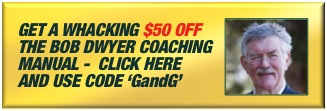I’ve talked a fair bit in recent weeks about support play. I praised the accuracy of the Samoan support play a few weeks back, but I have been critical of the lack of accuracy and urgency of the Wallabies in this vital aspect of play.
The Wallabies have some outstanding attacking players – genuine world-class. Quality support play that applies maximum pressure on defences at and around the tackle contest will provide genuine continuity – with options – and subsequently space for our attack. This is essential if we are to challenge for the Webb Ellis Cup.
These video clips provide us with different scenarios, but my key factors for accurate support play apply equally to each. In several parts of my Coaching Manual concerned with support play and tackle contest options, I stress that the essential function of the support player must be to remain in close contact with and available to support the ball-carrier, in and around the contact.
The aim of the support player at the tackle/contact situation is to help the ball-carrier to stay on his feet and to keep driving forward.
NEVER go past the ball-carrier in an attempt to predict the path of the ball. Be conservative and support each ball-carrier in turn.
Focus on the ball, and therefore on the individual ball-carrier. Follow his pace and his change of direction.
Move closer to support, either physically or as a potential ball-carrier, as you observe the ball carrier’s needs.
Support players have the total responsibility for making viable options available to the ball-carrier.
I could go on, but suffice to say you should refer back to these principles in your own assessment of support play.
[youtube]http://www.youtube.com/watch?v=QGd5qAi_jIA[/youtube]
The first clip shows a classic example of poor support play. Genia, Elsom and others combine to ask a difficult question of the defence and they come up with the wrong answer. Elsom breaks through with four forwards ideally placed to support – Horwill, Higginbotham ,Moore and Kepu – but the further Rocky runs, the further the support players get from him. It looks as if they are running away from him, not running to support him. None of them actually supports Rocky at all – in fact the first support player to arrive is Quade Cooper, who starts about 12 metres behind the forwards. Had any one of these forwards understood his role, a try would probably have been scored. Instead, we had a penalty to the Boks!
The second clip shows an excellent counter-attack opportunity, begun by Beale who gives Ioane some space. Kepu arrives in excellent support position – tight with depth – and takes the off-load from Ioane to draw more defence in this contest. Horwill and Moore hesitate – one of my pet hates – and could have added more to this attack, ‘by helping the ball-carrier to stay on his feet and to keep driving forward.’ Nevertheless, this small piece of accurate support play, by Kepu, creates concern for the now undermanned Bok defensive line and Cooper subsequently finds good space in behind for a 50-plus metre gain.
The third clip evidences a particularly common error; indeed, many people may disagree with my philosophy here – but not if they accept my general philosophy that support players must make ‘viable options available to the ball-carrier. This is another excellent counter opportunity – this one begun by Cooper and continued by Genia. Genia is looking for the half-break on an ‘overs’ line, running across to his left. He is therefore open to his left and has his back to any runner arriving from his right. It is very difficult for him to deliver any pass back on the inside. The correct line of support by Ioane is therefore to remain on Genia’s left – on his outside – but with depth. This depth will allow Ioane to keep all of the options open for Genia.
Genia may then (i) make the break, and pop the pass to Ioane, who can reaccelerate on to the ball; or (ii) sight Ioane easily on his left, drive/roll into the defender and deliver the ball back in behind to Ioane, who can then take the inside line, with Beale and Cooper looming up also. Anything could eventuate with this lot near the ball!
My specific comment in the Manual is ‘the support player, immediately outside of the ball-carrier, must (a) hold his line (straight) and slow his pace, and (b) remain always outside the ball-carrier. This will ensure that any switch pass can be executed as late as possible and as “skinny” as possible.’
As regular readers will know, I am fanatical about accurate execution of quality technique. My frustration derives from the fact that such execution is simple and effective. All of the faults listed above are caused by support players running too fast and/or on wrong lines. How difficult is it to (i) chase the ball, not some vague space, and (ii) to slow down? These faults are self-administered, with no influence whatsoever from the opposition.
I live in hope!



